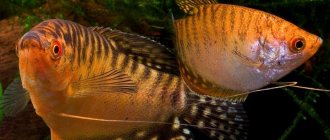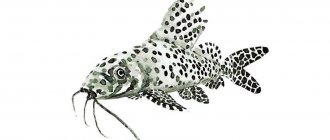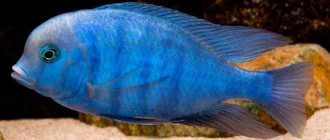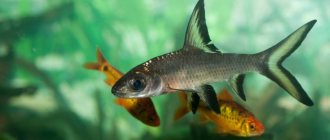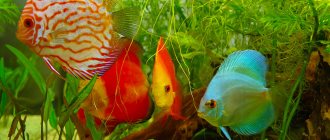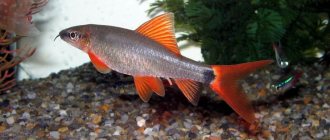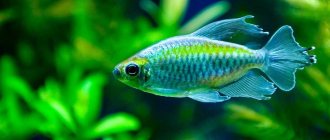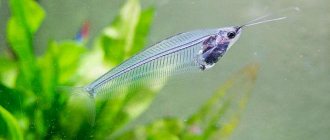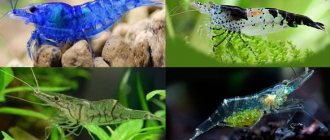Synodontis (Synodontis sp.) is a beautiful and large catfish from the Cirrus family. Nowadays this family includes over 130 species of catfish. The fish arrived in Europe in 1950. Their name translated into Russian means (fused teeth), which indicates the special structure of the jaws - 45-65 teeth located on the lower jaw grow together.
Synodontis are also called catfishes because they can swim and hang upside down. Thanks to this ability, they catch insects that have fallen on the water. When frightened or when removing catfish from the water, they use the first rays of the pectoral fins to make creaking sounds.
Synodontis are nocturnal, and during the day they most often rest, hiding in shelters. In the wild they live in small flocks.
Description
Synodontis ocellifer or synodontis changeling is a species of fish from the family Cirrus catfish. Naked catfish are considered a species due to the lack of scales. Instead of scales, the catfish's body is covered with mucus and is also protected by sharp fins.
Now the species is domesticated as an aquarium fish. Catfish are school animals. They live in small flocks of 4–8 individuals.
Appearance
The catfish is a fish with a massive and laterally compressed body. Representatives grow up to 15–30 cm. The head is large, flattened, with the presence of black spots. There are three pairs of whiskers on it. The lower whiskers are fringed or feathery, hence the name of the family. The dorsal and pectoral fins have sharp spines for protection. The caudal fin is well developed, a clear cut is visible. The color of the fins is dark.
The body color of shifter fish ranges from light to black. Individuals with a grayish-brown color are more common. On the back and sides there are dark spots that stand out against the general background of the body - black, red, gray, chestnut. Representatives with large black spots are more common. The abdomen is plain, without patterns.
Character
Catfish catfish are peaceful and non-aggressive inhabitants. The manifestation of aggression is provoked by fish leading a lifestyle similar to themselves - digging in the ground, staying in low layers of water. These individuals are perceived as potential enemies.
In other cases, catfish shifters are absolutely indifferent to other inhabitants of the aquarium.
Lifestyle
During the daytime, catfish are passive and inactive. They prefer to hide part of the day in algae and shelters in the aquarium, and stay awake at night. But some individuals are active during the day.
Behavior
The behavior of catfish shifters is similar to other species of catfish. They spend most of the day digging in the ground or hiding in a shelter.
Up to 80 percent of the time, catfish shifters swim belly up. The fish turn over and move around, feed and monitor their surrounding neighbors. Synodontis, which swims belly down, has a much darker belly than its back.
Lifespan
Synodontis fish can live up to 10 years at home. With improper feeding and maintenance, the lifespan of this catfish is significantly reduced to one or two years. In the wild they live for about 4–5 years.
History of the origin of catfish synodontis
Synodontis is an attractive catfish that came to us from Africa
The natural habitat of synodontis is the water bodies of the Republic of Congo and Cameroon. They are found in the Lekini and Malebo rivers. Catfish got their name due to the special structure of their jaws. "Synodontis" translates to "fused teeth." Synodontis belongs to the order Catfish, suborder Catfish, and family Mohawkidae. They were first brought to Europe in 1950.
Varieties
Changeling
Synodontis nigriventris was first discovered at the mouth of the Congo River. This is an ornamental African fish with unusual behavior. The fish spends most of its waking hours with its belly up: – the fish watches other inhabitants, looks out for food.
The body color is usually gray-brown with dark spots and lines. They grow up to 8–10 cm. They live 7–9 years.
Cuckoo
Cuckoo catfish or otherwise multispotted synodontis. It has a multi-pointed pale yellow color. Grows up to 15 cm.
Well kept with cichlids.
Veiled
Synodontis erupterus or veiled. It was called veil-shaped for its long, beautiful fins, which develop like a veil when swimming. Body color is brown-coffee with dark spots. The body size of veiled catfish is 15–20 cm, they live up to 10 years.
Angel
Synodontis angelicus or star-shaped synodontis. Many consider its beauty to be the most outstanding of the fish of the Cirrus family. Its beautiful appearance and decorative color make it a frequent pet in the aquarium. The body color is usually purple or coffee. It has spots of yellow or orange color. The body size is larger than many representatives - it reaches 25 cm. Angels live up to 15 years.
Flag
Synodontis decorus got its name - flag synodontis, because of the ray of the dorsal fin extended forward. The fish are gray in color with large dark spots. It grows up to 30 cm and lives for 15 years.
Other
There are also less common types of catfish:
- Dalmatian.
- Shoutedena.
- Scythe-fin.
- Nyassky.
- Leopard print.
- Brishara.
- Clown.
- Marble.
- Domino.
- Loti.
- Congo.
- Alberta.
A common feature of synodontis catfishes is dull coloration with the presence of multiple spots. All are distinguished by a calm disposition and lead a nocturnal lifestyle in low layers of water.
Maintaining Health
Synodontis are strong and hardy and get sick less often than other fish.
To maintain their health, simple and timely care, a comfortable living environment and quality feeding will be enough. The level of nitrates in the aquarium will negatively affect their health. It is necessary to ensure that their concentration does not exceed 30−40 mg/l. Nitrate levels are determined by special tests that can be purchased at a pet store.
Sometimes the color of catfish becomes lighter. This means that the fish was nervous. When it calms down, the color will become bright again.
If the catfish still gets sick, then you should not treat it yourself. Medicines that contain, even in small quantities, copper and salt are harmful to him. Only a qualified specialist can choose the right medicine for a sick catfish.
Synodontis are inquisitive fish that also show interest in what happens outside their glass house. They are not shy and friendly, and can be trained. If the person caring for them inspires trust in the catfish, then they will not only take food from your hand, but will also allow you to stroke their belly.
Content
Catfish quickly get used to being kept in an aquarium. The water should not be too hard and not too soft.
Aquarium
The size of the aquarium should match the size of the fish. For a 25 cm pet you will need a tank of about 200 liters. For smaller individuals – 120–150 liters.
There must be shelters in the aquarium. For each catfish, 1–2 shelters are provided. The soil should be round, without sharp edges. Sand, crushed pebbles and gravel are suitable. Aquarium equipment: aerating device, filter. They will maintain normal water for life.
The aquarium must be covered with a lid.
Water parameters
For the normal existence of skinwalkers, neutral acidity is necessary. The water temperature should not fluctuate sharply - within 25–28 degrees. The water is changed once or twice a week. Fish waste accumulates at the bottom of the aquarium, so cleaning is done. To clean, you need to siphon the soil. Partial cleansing occurs when changing the water.
Plants
The only requirement is that the plants should not have sharp edges or thorns, so that the delicate skin is not damaged. Stiff-leaved underwater plants are used, for example, Anubias, Congo fern, Aponogeton rigidifolia, Microsporum.
Plants should be planted quite deep, because catfish changelings love to dig through the soil in search of food. Or plant plants in pots.
Lighting
Catfish are undemanding when it comes to lighting. Any lamps are suitable, but not too bright, because catfish prefer darkened spaces.
Compatibility
The compatibility of catfish shifters with other types of fish is high, due to their peaceful nature. On rare occasions they become aggressive. This usually happens if an individual of another species leads the same lifestyle as the catfish. Species that prefer to spend time at the bottom of the aquarium become enemies and invaders of territory in the eyes of the fish. This causes conflicts.
The best neighbors for catfish shifters will be cichlids and tetras.
Several fish of the same species have average compatibility. If the inhabitants are approximately equal in strength and size, then they will get along. But if one of them is weaker and smaller, then they will oppress him, bite him, and take away food. At the first signs of oppression, the individual is placed in a separate tank.
You should not keep changelings with small fish species or fry. At night they will be attacked by catfish or eaten.
Who do catfish catfish and other synodontis live with?
Synodontis are large in size, and therefore get along well with predatory fish species. Changelings get along well with comparable species , but they are very voracious and therefore dangerous for small fish. The walrus catfish is quite peaceful, but with age it can become aggressive towards members of its own species. Eupterus is one of the few species that are compatible with African cichlids. Veiled synodontis are capable of showing aggression towards other bottom-dwelling fish, so it is better to house them with species that live in the middle and upper layers of water. Petrichola catfish boasts good compatibility with other fish. It can be considered the best choice for adding to an aquarium inhabited by fish of different sizes.
Synodontis have an unpleasant habit of eating the wounds of other fish. Moreover, they gnaw away the damage right to the bones. Therefore, it is important to promptly remove injured neighbors from the common aquarium. You should not return the fish to the community aquarium until the damage has completely healed.
Thus, synodontis catfish are unpretentious in keeping and not picky in feeding. These fish serve as aquarium orderlies: they clean the walls and soil of organic residues. They are peaceful, but have a good appetite, and therefore can easily eat small fish. Since most species of synodontis grow to considerable sizes, the fish need large, spacious aquariums with good aeration.
Reproduction
There is not much information available about the breeding of Synodontis and some are disputed by scientists.
In the wild, individuals migrate to spawn during the rainy season. Therefore, some aquarists advise cooling the water a few degrees to approach spawning time.
Females lay their eggs in holes or depressions that they find in advance. The female is capable of laying about 400 eggs.
After 5 days, catfish fry hatch from the eggs. At a young age they usually swim. But after 6 weeks they become like adult fish and turn over in the water. The fry feed on brine shrimp and small worms.
How to determine gender
There are no clear distinguishing features between male and female catfish shifters. Males have a more graceful and slender body structure and are usually smaller, while females are plumper and rounder, especially in the abdominal area. In males, a small genital outgrowth is located near the anal fin. Female skinwalkers have much larger spots on their body than males.
Breeding
In captivity, synodontis are bred using hormonal injections. The fish reach sexual maturity at the age of 1 year. For spawning you will need a container with a volume of 70 liters. A week before spawning, the female and male are placed in different aquariums and fed well. A net is placed at the bottom of the spawning tank to prevent the parents from eating the eggs.
The beginning of spawning is stimulated by raising the water temperature by 2-3 degrees and creating a current. The required dose of the hormone is injected. After 12 hours the fish will begin to spawn. The female lays about 500 eggs during one spawning. At the end of spawning, the spawners are removed from the spawning area. The eggs are incubated for 40 hours. All this time it is necessary to monitor the caviar and remove any that have turned white. The larvae will feed from the yolk sac for 4 days. Then they begin to feed with small food, gradually moving to larger ones. Juveniles grow unevenly.
Habitat in nature
In nature, fish live in various parts of Africa (rivers and lakes of Congo, Ivindo, Zambezi, Victoria, Tanganyika). Used by the local population as food.
Found only in fresh waters. They feel good both in muddy and dirty water and in clean water. In water they prefer to live in places with a rocky bottom, with a small amount of sand.
Diseases
Changelings are hardy fish with strong immunity. Most diseases bypass them. Immune to diseases that affect other species from the tropics.
Possible diseases:
- Obesity. Catfish tolerate hunger well and can go without food for several days without any problems. But overfeeding is dangerous. Especially food of animal origin. To return the body to normal, it is necessary to reduce the amount of food and arrange days without food once or twice a week to maintain tone.
- Stress. A symptom of stress is a pale, dull body color. Causes of stress: overcrowding of the aquarium, aggressive neighbors, lack of food. Observe the changeling and determine the cause of the stressful condition. Only then begin treatment.
- Oxygen starvation. It is easy to detect a lack of oxygen - the fish are lethargic, inactive, often open their mouths, and swim sideways. The cause of oxygen starvation is a breakdown of the aeration device. Hydrogen peroxide is added to quickly increase the oxygen level in the water.
- Fin rot. Bacteria live at the bottom of the aquarium. When a fish is weakened or sick, it lies on the bottom for a long time. This will lead to the appearance of putrefactive formations on the body. Treated with a streptocide bath.
Feeding
The cuckoo catfish is considered not only an omnivorous fish, but also an aquarium cleaner. He happily eats algae from the walls of the aquarium, worms, snails and, in some cases, even carrion.
For the full development of fish and further maintenance of its health, the animal’s diet should consist of 70% protein foods:
- Worms;
- Koretra;
- Insects.
The rest of the menu is occupied by plant and dry food.
Dry food should only be purchased at pet stores. They must be designed specifically for catfish. The serving size and its composition are indicated on the packaging.
Multispotted synodontis are prone to overeating, and, as a result, obesity. You need to feed the fish once a day in the late afternoon (1 - 2 hours before the end of daylight). The serving size is determined by the amount that the flock can eat in 4 - 5 minutes. Next, the remaining food is caught and removed.
Reviews
Most aquarists and catfish breeders note their quiet and peaceful character. Fish coexist seamlessly with all types of fish. Breeders love to watch the strange and unusual antics of the aquatic pet. Because of this, catfish are so popular.
Adviсe
- Keep 2–5 catfish.
- Set up a couple of covers.
- Don't overfeed catfish.
- Don't put them near small fish.
- Use only smooth primer without sharp corners.
Be sure to get these changeling fish. After all, in Japan there is special respect for catfish, because according to the Japanese legend about the structure of the world, the earth is located on the back of the great catfish Namazu.
Previous
Varieties of Tarakatum keeping and caring for catfish: difference between male and female fish, reproduction (breeding) at home, spawning, compatibility, description, photo
Next
Varieties of Ancistrus vulgaris catfish (fish stuck): maintenance, care, breeding, types, description
Great article 0
